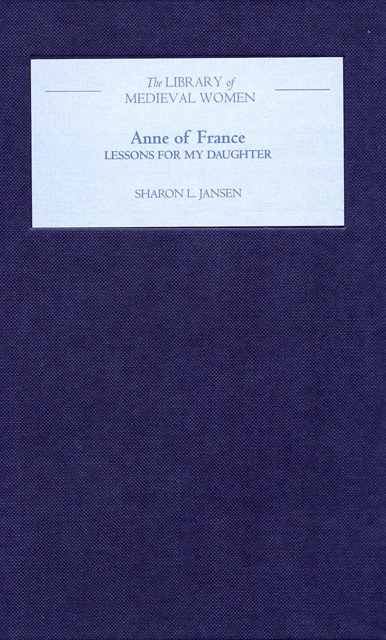Book contents
- Frontmatter
- Contents
- Dedication
- Preface
- Preface to the Paperback Edition
- Introduction
- A Note on the Translation
- Lessons for my Daughter
- Interpretive Essay
- Appendix I Louis XI, Anne of France, and the Regency Question
- Appendix II Unpublished Letters from Anne of France
- Select Bibliography
- Index
- Already Published Titles in this Series
Appendix I - Louis XI, Anne of France, and the Regency Question
Published online by Cambridge University Press: 17 March 2023
- Frontmatter
- Contents
- Dedication
- Preface
- Preface to the Paperback Edition
- Introduction
- A Note on the Translation
- Lessons for my Daughter
- Interpretive Essay
- Appendix I Louis XI, Anne of France, and the Regency Question
- Appendix II Unpublished Letters from Anne of France
- Select Bibliography
- Index
- Already Published Titles in this Series
Summary
Two questions are commonly raised about Louis XI’s arrangements for his son at the time of his death. First, why did he decide against a formal regency? Second, why did he put his son in his daughter’s guardianship instead of his wife’s?
In response to the first question, the answer provided by historian John Bridge is most sensible. At the time of Louis XI’s death on 30 August 1483, the dauphin Charles was just over thirteen years old, somewhat sickly, and completely inexperienced. By the terms of a statute of 1374, the age and legal majority of a king of France was defined as the heir’s attainment of his “fourteenth year.” There was some ambiguity in this law. As Bridge notes, “If [the wording of the statute] meant that a King attained his legal majority when he entered upon his fourteenth year, then Charles was legally of age, and no Regency would be required.” But “it was possible so to construe the ordinance as to postpone a sovereign’s majority until he reached his fourteenth birthday, and from this occasion Charles was still removed by the space of nearly a year.” There was “no binding precedent” for the king to cite, and the ambiguity of the situation would almost surely result in disagreement and dissent after his death. By avoiding a regency, the king avoided any arguments over interpretation and, more important, any early termination of his daughter’s guardianship, which extended into 1491, well after Charles VIII’s “fourteenth year,” whichever way that ambiguous phrase were to be interpreted.
The designation of a regent was also made difficult by the choice of a regent. Bridge indicated that a regency would “belong to the first Prince of the Blood,” in this case Louis of Orléans, who was also the heir presumptive and, thus, not necessarily the most disinterested of candidates. But an obvious candidate for regent was Charlotte of Savoy, the queen consort and mother of the dauphin; recent scholarship has, in fact, focused on the regency as what one historian has called a “vocation” for royal women. While the so-called Salic law denied women (like Anne of France herself) the right to inherit the crown of France, it did not deny them access to power.
- Type
- Chapter
- Information
- Anne of FranceLessons for my Daughter, pp. 91 - 94Publisher: Boydell & BrewerPrint publication year: 2004

